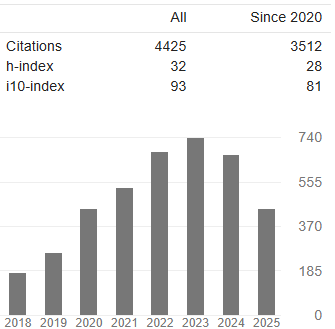BONE ALUMINUM AS A BIOLOGICAL MONITORING OF OCCUPATIONAL EXPOSURE TO ALUMINUM
Downloads
ABSTRACT
The current proposed biological monitoring of aluminum is based on the analysis of aluminum concentration in blood/serum or in urine, but both considered to be reflective of short-term exposure. Based on its toxic kinetics, aluminum has been demonstrated to be accumulated in the bone. The aim of this study is to find out whether by analyzing bone aluminum, we might have an overview of aluminum accumulation that might cause health problems in the future. This review was conducted through a method of search and selection of articles from Pubmed, Cochrane Library, and Google Scholar databases aimed to answer question rising from the problem statement of this study. The process of searching articles used the keywords "occupational aluminum” OR "bone aluminum” AND "biological monitoring” OR "biomonitoring”. The selection of articles was performed using the defined inclusion and exclusion criteria. Initially, 61 articles were obtained, but after the selection process and hand searching, four articles remained consisting of two case reports and two cross sectional studies. Based on the selected evidence-based resources, bone can be a promising potential biomarker of aluminum, especially for cumulative exposure assessment. The use of in vivo neutron activation analysis (IVNAA) or X-ray fluorescence (XRF) technology for the purpose of noninvasively quantifying aluminum concentration in the bone, is suitable enough to be performed in occupational settings.
Keywords:Bone aluminum, occupational exposure, IVNAA, XRF, biomonitoring, biological monitoring
Agency for Toxic Substances and Disease Registry (2008) Toxicological Profile for Aluminium. Atlanta.
Aslam et al. (2009) ‘Noninvasive measurement of aluminium in human bone: Preliminary human study and improved system performance', Journal of Inorganic Biochemistry, 103(11), pp. 1585–1590. doi: 10.1016/j.jinorgbio.2009.07.021.
Assunçí£o, J. H. et al. (2017) ‘Multifocal osteonecrosis secondary to occupational exposure to aluminum', Acta Ortop Bras, 25(3), pp. 103–6. doi: 10.1590/1413-785220172503170760.
Dwijananti, P. et al. (2018) ‘Determination of elements in hospital waste with neutron activation analysis method', Journal of Physics: Conference Series. Institute of Physics Publishing, 983(1), p. 12017. doi: 10.1088/1742-6596/983/1/012017.
Elinder, C.-G. et al. (1991) ‘Evidence of aluminium accumulation in aluminium welders', British Journal of Industrial Medicine, 48, pp. 735–738. doi: 10.1136/oem.48.11.735.
Ferguson, G. et al. (2018) ‘Systematic review of occupational aluminium exposure and adverse health condition'. Mississauga.
Hasan, Z. et al. (2020) ‘Characterization of bone aluminum, a potential biomarker of cumulative exposure, within an occupational population from Zunyi, China', Journal of Trace Elements in Medicine and Biology. Elsevier GmbH, 59, p. 126469. doi: 10.1016/j.jtemb.2020.126469.
Hutapea, R. M. (2019) The effect of aluminum dust exposure on lung function disorders in workers at CV Aluminum Mandiri Palembang. Sriwijaya University.
Igbokwe, I. O., Igwenagu, E. and Igbokwe, N. A. (2019) ‘Aluminium toxicosis: a review of toxic actions and effects.', Interdisciplinary toxicology. Sciendo, 12(2), pp. 45–70. doi: 10.2478/intox-2019-0007.
INALUM (2019) INALUM Commits Aluminium Production to Boost Aluminium-Based Industry.
Inan-Eroglu, E. and Ayaz, A. (2018) ‘Is aluminum exposure a risk factor for neurological disorders?', Journal of Research in Medical Sciences. Wolters Kluwer Medknow Publications, 23(1). doi: 10.4103/jrms.JRMS_921_17.
Joanna Briggs Institute (2017) Checklist for Case Reports. Adelaide.
Klein, G. L. (2019) ‘Aluminum toxicity to bone: A multisystem effect?', Osteoporosis and Sarcopenia. Elsevier BV, 5(1), pp. 2–5. doi: 10.1016/j.afos.2019.01.001.
Müller, J. (2020) Aluminium production Indonesia 2010-2019.
Oxford Centre for Evidence Based Medicine (CEBM) (2009) Oxford Centre for Evidence-Based Medicine: Levels of Evidence, Levels of Evidence.
Oxford Centre for Evidence Based Medicine (CEBM) (2020) Critical appraisal tools, EBM Tools.
Riihimäki, V. and Aitio, A. (2012) ‘Occupational exposure to aluminum and its biomonitoring in perspective', Critical Reviews in Toxicology, 42(10), pp. 827–853. doi: 10.3109/10408444.2012.725027.
Roesfitawati (2017) Aluminium Industry in Indonesia. Jakarta.
Shulyakova, O., Avtonomov, P. and Kornienko, V. (2015) ‘New Developments of Neutron Activation Analysis Applications', Procedia - Social and Behavioral Sciences. Elsevier BV, 195, pp. 2717–2725. doi: 10.1016/j.sbspro.2015.06.380.
Suwanto, Y. E. P. (2018) ‘Analysis of Physical Environment Factors and The Characteristics of Workers with Respiratory Complaints in an Aluminum Pot Industry', Jurnal Kesehatan Lingkungan. Universitas Airlangga, 10(4), p. 409. doi: 10.20473/jkl.v10i4.2018.409-416.
- The authors agree to transfer the transfer copyright of the article to The Indonesian Journal of Public Health effective if and when the paper is accepted for publication.
- Authors and other parties are bound to the Creative Commons Attribution-NonCommercial-ShareAlike 4.0 International License for the published articles, legal formal aspect of journal publication accessibility refers to Creative Commons Attribution-NonCommercial-ShareAlike 4.0 International License (CC BY-NC-SA), implies that:
- Attribution ” You must give appropriate credit, provide a link to the license, and indicate if changes were made. You may do so in any reasonable manner, but not in any way that suggests the licensor endorses you or your use.
- NonCommercial ” You may not use the material for commercial purposes.
- ShareAlike ” If you remix, transform, or build upon the material, you must distribute your contributions under the same license as the original.































